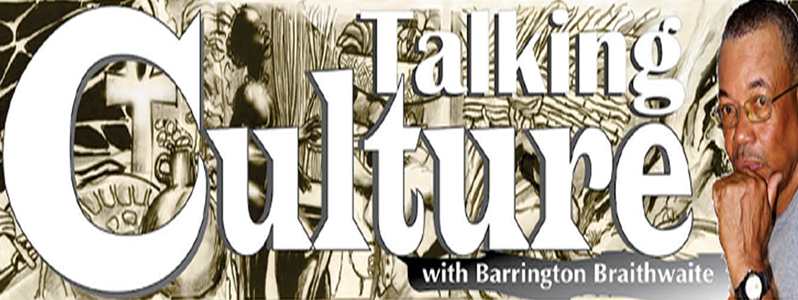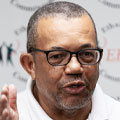… and we create to the bitter end, words for a fallen Artist
IT doesn’t matter to the Muse, she will inspire the soul to create, whether like the outcast bird in the movie ‘BE’, there is an audience to approve or, one who is indifferent because the creative rhythms does not beat in that soul until the task is done, and the intuitive process is complete and the imaginative becomes manifest.
This is part of a conversation, not in the exact words, that I had with Hubert Edwards, former Lieutenant of the GPM and artist. Eddie passed a week ago, and was buried the day after my wife saw a flash of his Death Announcement on TV. Upon enquiring, I learnt that the two days followed consecutively and it was over.
Eddie grew up on Saffon Street Charlestown; I had family on Drysdale Street but we didn’t know each other then, he was older that I am, and from our later conversations lived in a different world, so we never met until we were adults. He went through experiences that while in our friendship we would discuss cause and effects, and in those conversations he related that his step-father had imposed on his mind a certain denunciation of self, in preference for another, which he pursued, and time and time again proved his undoing, resulting in serious setbacks.
We would chat at his comic book exchange store on Broad Street, then after experiencing a fire there, he moved into the La Penitence market and I would exchange books there. Eddie had made the newspapers in the early 70s after creating a knowledge-based game.
For readers who don’t know, back then we were rated as one of the more literate of the CARICOM nations, novels were exchanged on the water front, in offices and in schools where comic books reigned supreme. Both English and American brands were new on the bookstore shelves, then to the exchange market, and the one local comic book creator Rudy Seymour’s books were coveted. The exchange book stand sustained families, and were always busy, each market had several; they were stacked with second-hand novels, magazines, comic books, nonfiction and also ‘Adult’ stuff. Then there were the official bookstores, Graphic, Universal, Fogarty’s, Argosy, GNTC, the super popular Ifill’s in Stabroek Market and Lachmansingh’s Drug Store on Camp Street between Princes and Norton Street. The Forbes Burnham government encouraged local creativity, opening a world that had never before challenged local talents. I jumped into the arena before Eddie with a badly illustrated ‘The Shrouded Legacy’ in 1981,in the Chronicle and the criticisms from colleagues demanded investment in books, courses, and the setting up a semi-comfortable studio. Eddie published an illustrated edition of `Joan of Arc’ in the mid 90’s, after emerging from the experience of a major pitfall. Though I could not understand the choice of the subject matter, I provided what references on period armour I had. My encouragement revolved around Eddie developing a semi studio, comfortable enough to enable him to produce work at a professional level, this time with a local bias. Eddie’s major problem was the much-taken-for-granted development of such a much-needed operations space, and equipping it, and mastering the tools and techniques necessary to compete with the rest of the world. The technological face of illustrated story- telling had jumped leaps and bounds.
When in the 90s I travelled to the USA, I would return with trade books, dip pens, Fantasy art publications and Sunday edition pullouts of the Daily News cartoon section that he added to the Conan collection and whatever was necessary for the general morgue.
In the early 90s, I had done with the support of UNICEF, the first illustrated story on HIV-AIDS in Guyana, which I don’t think that the Ministry of Education ever distributed. I encouraged him to do something on the subject which he did for the DF; I’m not sure how that went. Eddie then proceeded to throw himself into a project we had spoken a lot about, an illustrated edition of the Guyana/Venezuelan border controversy. I lent him what books I had on the subject, but I feared Eddie’s management of such a task from the standpoint of the graphic storyboards. Nonfiction historical projects like that would need a tremendous volume of portraits, lithographs and photographic references, all certified as period accurate. Artists in Guyana didn’t have the support of grants, and we didn’t have the museums or libraries either. Ironically, we do have the people and the enthusiasm, regardless, a lot of Amazon shopping and paid access to data payments would have to be done. Eddie dropped the illustrated edition and resorted to a general book on the subject, with accompanying illustrations of the major players that he would render. And because there was no finance to license the original pictures, he went to then President Jagdeo with the book; he interpreted thumbs up and was sent to Rohee, who dismissed it. After 2015 he proceeded to explore other aspects of his talents, connected with a mutual friend, Ronald Austin at Foreign Affairs, received support and informed me he was making adjustments to the book. By then, he was once hospitalised with prostate issues, and I knew that the adequate, self-generated atmosphere that a man feels comfortable with, to aid his healing was not there. The last time we spoke, he was considering a project on the emergence of the Hebrew nation a controversial subject that I had some insights of, we did discuss the angle he would take and arranged some follow-up discourses.
Eddie passed between the 12 and 14 January, 2019 and was quietly buried. To me, his artistic efforts placed him in the brother/sisterhood of artists, thus, this, his abridged story needs to be told.
Farewell brother.












